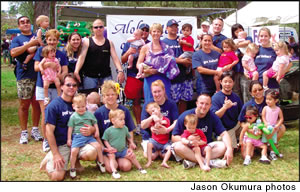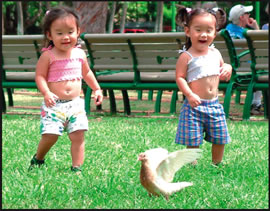Twins, Triplets & Quads Oh My!
For parents of ‘multiples’ the joy as well as the work also multiply, so they meet for support, to share advice and to swap baby clothes

By .(JavaScript must be enabled to view this email address)
E-mail this story | Print this page | Archive | RSS

Unfortunately with multiples, twice the cuteness and joy also means twice the work — 20 diaper changes instead of 10, two mouths to feed instead of one, four feet to chase instead of two — and still only 24 hours in a day to get it all done.
And that’s just for twins. Triple those numbers for some of the moms in the Aloha Mothers of Multiples Club.
As Hawaii’s only such multiples club, linked to the National Organization of Mothers of Twins Clubs Inc., the group has evolved to meet the unique needs of Hawaii parents over its nearly 40 years of existence. It’s grown dramatically into a 71-member support group with meetings, outings, newsletters, a website and even a new board position focussed on the extra help needed for military mothers.

Helping raise funds for a worthy cause are AMOM Club
members and their families at this year’s March of Dimes.
Pictured are: (back from left) the Alanas, the Benders,
the Smiths, the Andrades, the Walds, the McBrides,
(front from left) the Ottos, the Braegelmanns and the
Okumuras
The only criteria to join is either bearing or having borne a set of twins, triplets, quads or more. Yet simply living in Hawaii lessens the odds of membership. In a study of multiple births in the United States, Hawaii scored the lowest, coming in at about 30 percent below the national average. And with Asian residents under 25 — and not a fraternal twin — the odds are almost entirely against admission to the club.
There’s something fascinating about twins, triplets and quadruplets that makes people stop, stare and wonder just how cool it must be. For the parents of these little bundles of joy, however, it’s not all “oohs” and “aahs.” It also means unique challenges that only another mother with a similar brood can understand.

Trunk or Treat — last year’s AMOM’s Halloween event
for the kids
“It’s nice to discuss things with other parents of twins, because they know exactly what’s going on and can relate,” says Alison Okumura, outgoing club president and mother of 2-year-old twin girls. “The club also provides great advice on how to deal with the different problems encountered during infancy and toddlerhood. It benefited us greatly, especially in infancy, because a well-versed mother gave us great advice on all issues ranging from bottle feedings, to how to relieve gas and how to get them to sleep through the night.”
At the club’s meetings on the third Thursday of every month, moms and even some keiki arrive for a relaxing couple hours to chat, discuss upcoming activities, hear guest speakers, ask questions and get in on some good bargains.
The clothing and equipment swap is one highlight, where moms bring in clothes and toys their children have outgrown and trade for clothes from bigger children in the group.

Gathering at Kids Day 2004 are (back left to right) the
Pena and the Okumuras, (middle) the Keartons,
the Ottos, the McBrides, the Horvaths, (front) the
Oravetzs and the Andrades
“We have the swap about once every six months, and it’s really a great thing,” says Maria Andrade, membership chairwoman and mother of 2- year-old boy and girl twins. “Everything that is not taken is donated to different charities.”
Aside from the monthly meetings — where moms are rewarded with a night out of the house — the club also plans socials, family outings and an occasional moms’ night out.
A day at the zoo, the March of Dimes walk, a picnic in the park are all possibilities. Members recently attended Sesame Street Live at the Blaisdell, which was a fun time plus a great money-saver with discounted tickets for the two 50-person groups.
Mothers of twins dominate the roster, which has a couple of triplet moms on board. The average age of the keiki is about 2 years, and almost half of the moms are military. Annual dues are $30 which includes newsletters and attendance at all meetings and events.
But the moms agree that it’s the support and camaraderie that help the most. Instead of tackling motherhood of multiples alone, it’s comforting and reassuring to listen and chat with others in the same boat.

Raeson and Leeson Okumura have fun chasing
birds at the March of Dimes WalkAmerica event
“When you have two the same age, it just makes everything harder,” admits Andrade. “For instance there’s no such thing as just running to the store to get milk. Everything becomes a chore, and you have to plan a little bit more.”
While these moms readily share their frustrations, they also gush about how great it is to have twice the smiles and twice the love.
“The first year is the hardest,” Andrade says, “but once you hit that year mark it’s just such a joy because they can enjoy each other and it’s like they have a play date. I know
when my two wake up, I leave them in the crib for 30 minutes to give them time to really enjoy each other before there’s adult contact.”
With all this talk about moms, let’s not leave out the dads. Fathers are welcome at all club events, and many of them do attend — because with the Aloha Mothers of Multiples Club, more is always merrier.
Neat Facts About Multiples
• Hawaii has the lowest incidence of multiples of all 50 states.
• The rate for identical multiples is random and universal. The chances of having identical twins is about 1 in 285.
• Only fraternal (non-identical) twins are influenced by heredity. If you are a fraternal twin, you have a 1 in 17 chance of having twins. If your mother is a fraternal twin, you may have a higher-than-average chance of twins. If your father is a twin and you are a female, it may slightly increase your chances. If your husband is a twin or has twins in his family, it doesn’t affect your chances of having twins.
• Older mothers are more likely to have twins. It’s thought that the body accelerates ovulation as the biological clock ticks faster — 17 percent of moms over 45 have multiples.
• Africans have the highest incidence of twins at 16 per 1,000 births, and Asians have the lowest at 3 per 1,000 births.
• It is estimated that 60 percent of triplets are the result of fertility-enhancing treatments.
• About 1 in 50 people is a fraternal twin in the U.S., and 1 in 150 is an identical twin.
Page 1 of 1 pages for this story
E-mail this story | Print this page | Comments (0) | Archive | RSS
Most Recent Comment(s):
Commenting is not available in this weblog entry.







